TTM Technologies Bundle
Who Buys from TTM Technologies?
In the fast-paced world of technology manufacturing, understanding TTM Technologies SWOT Analysis is crucial for success. For a company like TTM Technologies, a deep dive into its customer demographics and target market is essential. This is especially true given its evolution from PCB manufacturing to advanced engineered systems.
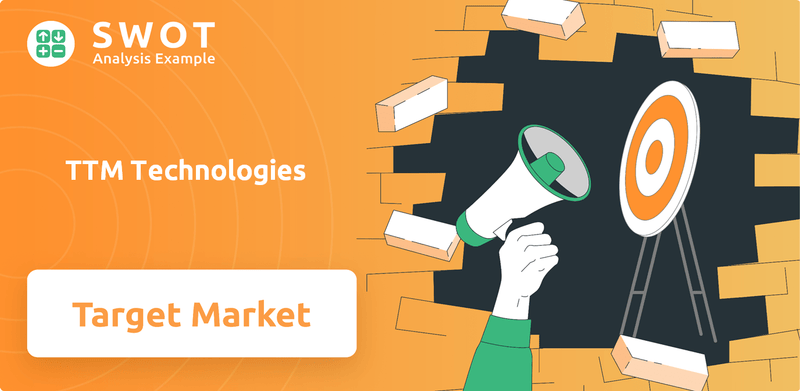
This exploration into TTM Technologies' customer base will provide a comprehensive market analysis, revealing the TTM company's strategic approach to customer segmentation. We'll analyze the industries TTM Technologies serves, detailing their customer profile, needs, and buying behavior. Ultimately, this analysis aims to define TTM Technologies' target market, assess customer acquisition and retention strategies, and evaluate customer satisfaction and lifetime value.
Who Are TTM Technologies’s Main Customers?
Understanding the customer demographics and target market of TTM Technologies is crucial for grasping its business strategy. TTM Technologies operates primarily in the business-to-business (B2B) sector, focusing on providing advanced electronic manufacturing services. The company's customer base is diverse, spanning several technology-driven end-markets.
A detailed market analysis reveals that TTM Technologies caters to key industries, each with specific needs and demands. This segmentation helps in understanding the company's revenue distribution and growth potential. The customer profile of TTM Technologies is shaped by its focus on high-tech manufacturing solutions.
The company's customer acquisition strategy and retention rates are influenced by the specific requirements of each segment. Analyzing the customer buying behavior and understanding customer needs and wants are essential for TTM Technologies to maintain its market share and enhance customer satisfaction. The Brief History of TTM Technologies provides additional context.
The Aerospace and Defense segment is consistently the largest revenue contributor for TTM Technologies. In Q4 2024 and Q1 2025, this segment accounted for 47% of total sales. This segment benefits from long product life cycles.
The Data Center Computing market is a significant growth area for TTM Technologies. It contributed 22% of total sales in Q4 2024 and 21% in Q1 2025. The growth was driven by the demand for generative AI applications, with a 44% year-on-year growth in Q4 2024.
The Automotive segment accounted for 13% of FY 2024 net sales. This segment experienced year-over-year declines in Q4 2024 due to lower demand and inventory normalization.
The Medical/Industrial/Instrumentation segment contributed 14% of FY 2024 net sales and 13% of Q4 2024 sales. It experienced year-over-year declines due to lower demand and inventory normalization.
Networking/Communications represented 6% of FY 2024 net sales. This segment saw a strong 35% year-on-year growth in Q4 2024, driven by AI-related demand and new products.
- TTM Technologies strategically diversifies its end-market mix.
- The company focuses on expanding its presence in existing markets.
- There is a focus on opportunities that strengthen leading-edge technology capabilities.
- Market research and external trends, like the rise of generative AI, drive these shifts.
TTM Technologies SWOT Analysis
- Complete SWOT Breakdown
- Fully Customizable
- Editable in Excel & Word
- Professional Formatting
- Investor-Ready Format
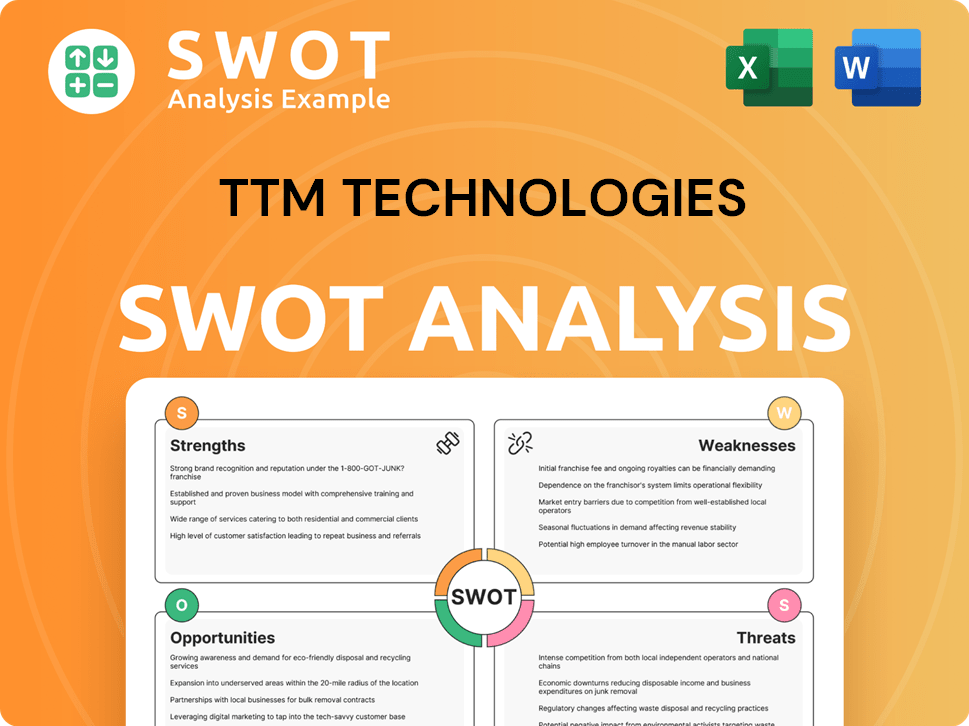
What Do TTM Technologies’s Customers Want?
Understanding the customer needs and preferences is crucial for TTM Technologies' success. Their primary customers, which are businesses, are driven by the need for advanced electronic solutions. These solutions must meet high-performance standards, reliability, and cutting-edge technology, often with tight 'time-to-market' requirements.
The purchasing decisions of TTM Technologies' customers are heavily influenced by factors such as technological advancement, stringent quality control, and security. They also prioritize the ability to quickly develop and launch new products. This focus is particularly evident in sectors like Aerospace and Defense, where specialized printed circuit board production is critical.
The company's adaptability and responsiveness to market trends are key. For example, the surge in generative AI has directly influenced TTM Technologies' focus and growth in the Data Center Computing and Networking sectors.
Customers in this sector prioritize reliability and long product life cycles. They require specialized, high-technology printed circuit board production to support national security requirements. The acquisition of Telephonics in 2022 broadened TTM Technologies' offerings in intelligence, surveillance, and communications solutions.
The main driver for customers in this segment is the need for high-performance PCBs and RF components. This demand supports rapid advancements in generative AI applications. Quick turnaround and technologically advanced solutions are essential to keep pace with innovation.
Across all segments, customers seek a 'one-stop solution' for electronic manufacturing services. This approach allows them to shorten development cycles and accelerate market entry. TTM Technologies addresses common pain points by offering differentiated capabilities.
TTM Technologies provides advanced design-to-specification engineering support, testing, components, and specialized assembly. They also engage in co-development of new products and capture new technology products for next-generation equipment. This demonstrates an adaptive approach to evolving customer needs.
Feedback from market trends, particularly the surge in generative AI, has directly influenced TTM Technologies' focus and growth in the Data Center Computing and Networking sectors. This adaptability is crucial for maintaining a competitive edge.
The company's customer acquisition strategy is likely focused on building relationships with key players in the Aerospace and Defense, Data Center Computing, and Networking sectors. Understanding the specific needs of each sector is critical for effective customer acquisition and retention.
The TTM Technologies customer profile is characterized by businesses that require high-performance, reliable, and technologically advanced electronic solutions. Their buying behavior is influenced by the need for cutting-edge technology, stringent quality standards, and rapid product development. The company's ability to provide a 'one-stop solution' and adapt to market trends, such as the rise of generative AI, is key to meeting these customer needs. In 2024, the global PCB market was valued at approximately $78.9 billion and is projected to reach $92.2 billion by 2029, indicating a growing market for TTM Technologies services.
The following points summarize the core needs and preferences of TTM Technologies' customers:
- High-Performance Solutions: Customers require electronic solutions that meet demanding performance standards.
- Reliability: Products must be reliable and durable, especially in critical applications.
- Advanced Technology: The need for cutting-edge technology is a primary driver.
- Quality Standards: Stringent quality control is essential to meet industry and customer requirements.
- Rapid Time-to-Market: Customers need solutions that enable quick product development and launch.
- 'One-Stop Solution': The preference for comprehensive electronic manufacturing services to streamline processes.
TTM Technologies PESTLE Analysis
- Covers All 6 PESTLE Categories
- No Research Needed – Save Hours of Work
- Built by Experts, Trusted by Consultants
- Instant Download, Ready to Use
- 100% Editable, Fully Customizable
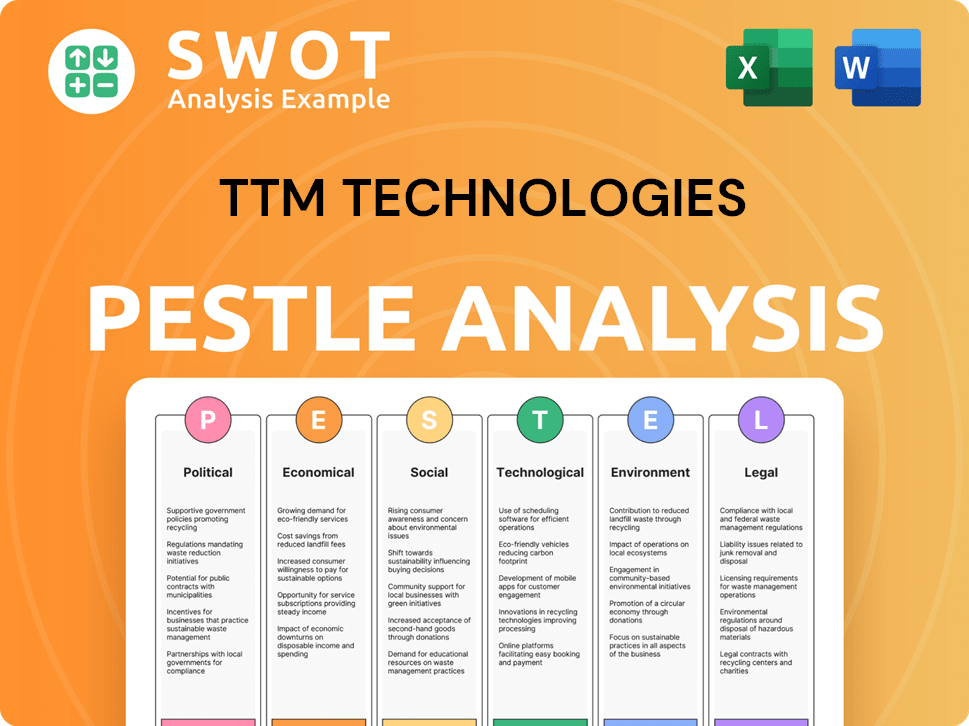
Where does TTM Technologies operate?
The geographical market presence of TTM Technologies is a crucial aspect of its business strategy. With a significant global footprint, the company strategically positions itself to serve a diverse customer base. This widespread presence enables effective customer engagement and localized service offerings.
TTM operates 23 specialized facilities across North America and the Asia Pacific regions. This extensive network supports the company's ability to deliver time-critical, one-stop manufacturing services to customers worldwide. The company's strategy includes leveraging its global presence to engage customers from concept to production, aiming to improve market share.
The company's ability to adapt to varying market demands and operational requirements is evident through its diversified manufacturing footprint. While specific regional differences in customer demographics or buying power are not explicitly detailed, the strategic placement of facilities suggests a tailored approach to different markets.
In North America, TTM has a strong operational presence, including a planned new facility in Syracuse, New York. This new facility will focus on specialized high-technology PCB production. The company's North America PCB capacity utilization was 35% in Q1 2025.
As of Q1 2025, 55.22% of TTM's total revenue came from the United States. This highlights the importance of the North American market for the company's overall financial performance. The company's focus on national security requirements further solidifies its presence in the region.
TTM also has manufacturing facilities in the Asia Pacific region, including those in China and Malaysia. Asia Pacific PCB capacity utilization improved to 58% in Q1 2025 from 52% in the prior year. This improvement indicates growing demand and efficient operations in the region.
Taiwan contributed 8.36% of total revenue in Q1 2025, with 'Other' regions accounting for 36.53%. This shows a diversified revenue stream within the Asia Pacific region. For more insights, explore the Marketing Strategy of TTM Technologies.
TTM Technologies Business Model Canvas
- Complete 9-Block Business Model Canvas
- Effortlessly Communicate Your Business Strategy
- Investor-Ready BMC Format
- 100% Editable and Customizable
- Clear and Structured Layout
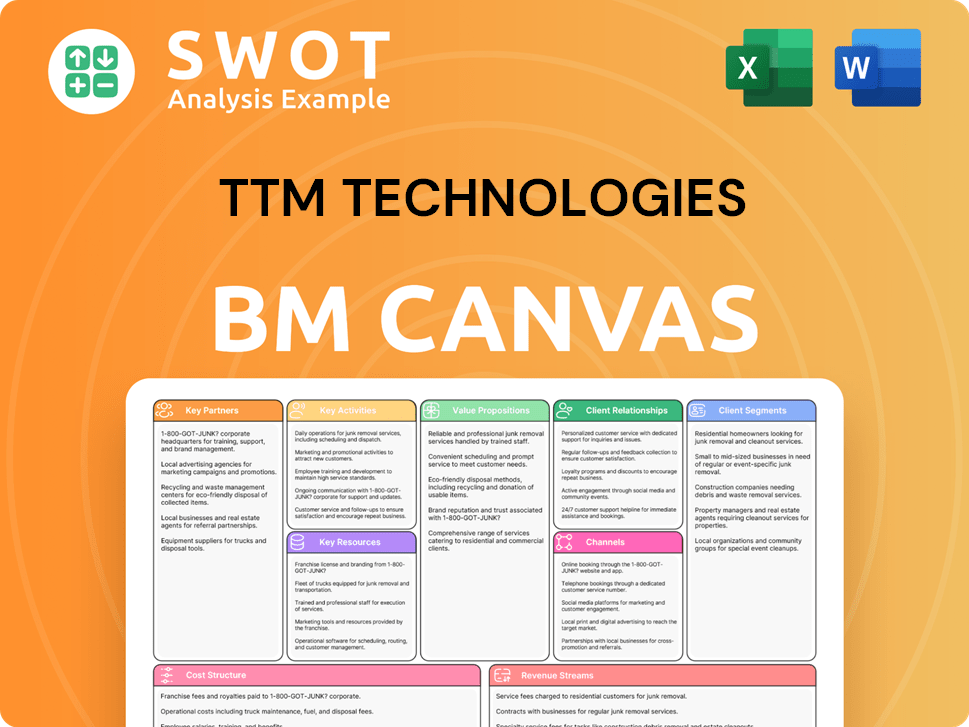
How Does TTM Technologies Win & Keep Customers?
The company, formerly known as TTM Technologies, focuses on a robust customer acquisition and retention strategy, particularly within the B2B sector. Their approach emphasizes a 'time-to-market' value proposition, offering comprehensive engineering support and specialized manufacturing services. This strategy aims to shorten product development cycles for clients, making it a compelling choice for companies seeking efficient and integrated solutions. The company's customer acquisition strategy is deeply intertwined with its product offerings and market focus.
The company actively engages in co-development projects and targets new technology products, especially those related to next-generation equipment. Strategic acquisitions have broadened its technological capabilities and product offerings, attracting new customers in specialized areas. The company's focus on growing end markets like Aerospace and Defense, Data Center Computing, and Networking, especially those driven by generative AI, serves as a key acquisition driver. This targeted approach helps the company to identify and attract the right customers.
Customer retention is supported by a 'customer-driven culture' that prioritizes service and execution. While specific CRM systems are not detailed, the emphasis on early engagement and operational excellence suggests a focus on building strong, long-term relationships. The substantial and growing Aerospace and Defense program backlog indicates strong customer loyalty and repeat business. The company's financial performance also contributes to customer confidence and retention, as is evident from its Q1 2025 financial results.
The company utilizes several strategies to acquire new customers, including co-development projects and targeting new technology products. Strategic acquisitions, such as Anaren (2018) and Telephonics (2022), have expanded its technological capabilities. Focusing on growth markets like Aerospace and Defense, Data Center Computing, and Networking, especially those driven by generative AI, is a key acquisition driver.
The company's target market includes industries such as Aerospace and Defense, Data Center Computing, and Networking. These markets are chosen for their growth potential and the demand for advanced manufacturing solutions. The company's ability to offer specialized services makes it a strong player in these key sectors. The focus on these markets is critical for both customer acquisition and revenue growth.
Customer retention is achieved through a customer-driven culture that emphasizes superior service and operational execution. The company builds strong relationships by focusing on early engagement and technology breadth. The substantial and growing Aerospace and Defense program backlog, which reached $1.56 billion in FY 2024 and $1.55 billion in Q1 2025, indicates strong customer loyalty. Consistent financial performance, with revenue growth and strong non-GAAP EPS in Q1 2025, also boosts customer confidence.
The company's consistent financial performance plays a crucial role in maintaining customer confidence and loyalty. The positive financial results, including revenue growth and strong non-GAAP EPS in Q1 2025, reassure customers about the company's stability and reliability. This financial health supports the company's ability to deliver on its commitments and maintain long-term relationships. For further insights into the company's performance, explore Owners & Shareholders of TTM Technologies.
TTM Technologies Porter's Five Forces Analysis
- Covers All 5 Competitive Forces in Detail
- Structured for Consultants, Students, and Founders
- 100% Editable in Microsoft Word & Excel
- Instant Digital Download – Use Immediately
- Compatible with Mac & PC – Fully Unlocked
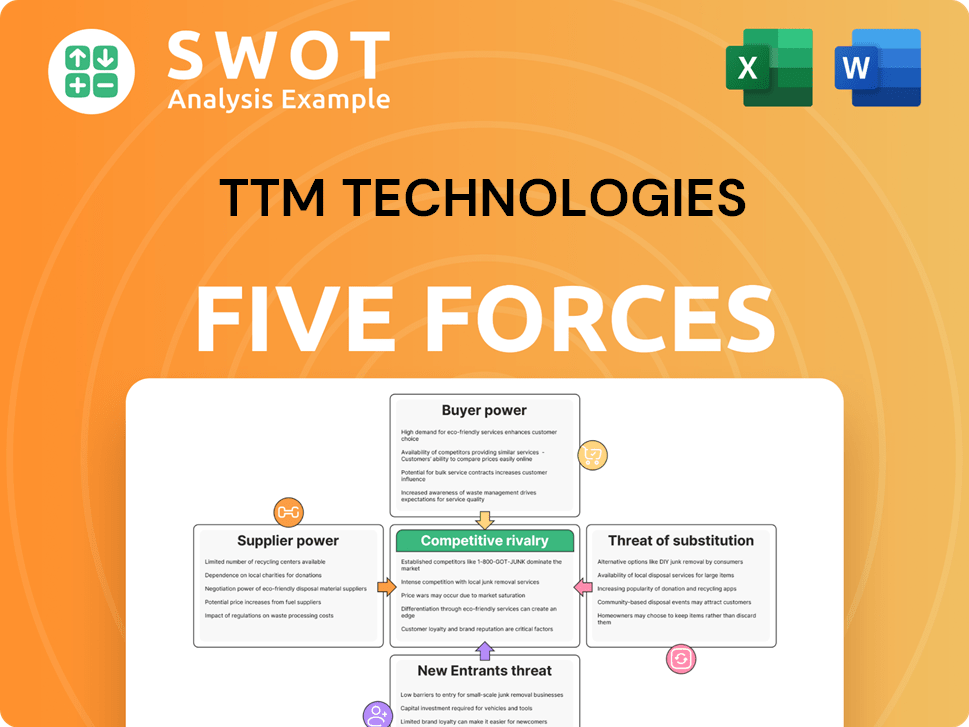
Related Blogs
- What are Mission Vision & Core Values of TTM Technologies Company?
- What is Competitive Landscape of TTM Technologies Company?
- What is Growth Strategy and Future Prospects of TTM Technologies Company?
- How Does TTM Technologies Company Work?
- What is Sales and Marketing Strategy of TTM Technologies Company?
- What is Brief History of TTM Technologies Company?
- Who Owns TTM Technologies Company?
Disclaimer
All information, articles, and product details provided on this website are for general informational and educational purposes only. We do not claim any ownership over, nor do we intend to infringe upon, any trademarks, copyrights, logos, brand names, or other intellectual property mentioned or depicted on this site. Such intellectual property remains the property of its respective owners, and any references here are made solely for identification or informational purposes, without implying any affiliation, endorsement, or partnership.
We make no representations or warranties, express or implied, regarding the accuracy, completeness, or suitability of any content or products presented. Nothing on this website should be construed as legal, tax, investment, financial, medical, or other professional advice. In addition, no part of this site—including articles or product references—constitutes a solicitation, recommendation, endorsement, advertisement, or offer to buy or sell any securities, franchises, or other financial instruments, particularly in jurisdictions where such activity would be unlawful.
All content is of a general nature and may not address the specific circumstances of any individual or entity. It is not a substitute for professional advice or services. Any actions you take based on the information provided here are strictly at your own risk. You accept full responsibility for any decisions or outcomes arising from your use of this website and agree to release us from any liability in connection with your use of, or reliance upon, the content or products found herein.